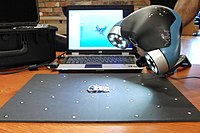
Photo from wikipedia
The automatic extraction of buildings from high-resolution aerial imagery plays a significant role in many urban applications. Recently, the convolution neural network (CNN) has gained much attention in remote sensing… Click to show full abstract
The automatic extraction of buildings from high-resolution aerial imagery plays a significant role in many urban applications. Recently, the convolution neural network (CNN) has gained much attention in remote sensing field and achieved a remarkable performance in building segmentation from visible aerial images. However, most of the existing CNN-based methods still have the problem of tending to produce predictions with poor boundaries. To address this problem, in this article, a novel semantic segmentation neural network named edge-detail-network (E-D-Net) is proposed for building segmentation from visible aerial images. The proposed E-D-Net consists of two subnetworks E-Net and D-Net. On the one hand, E-Net is designed to capture and preserve the edge information of the images. On the other hand, D-Net is designed to refine the results of E-Net and get a prediction with higher detail quality. Furthermore, a novel fusion strategy, which combines the outputs of the two subnetworks is proposed to integrate edge information with fine details. Experimental results on the INRIA aerial image labeling dataset and the ISPRS Vaihingen 2-D semantic labeling dataset demonstrate that, compared with the existing CNN-based model, the proposed E-D-Net provides noticeably more robust and higher building extraction performance, thus making it a useful tool for practical application scenarios.
Journal Title: IEEE Journal of Selected Topics in Applied Earth Observations and Remote Sensing
Year Published: 2021
Link to full text (if available)
Share on Social Media: Sign Up to like & get
recommendations!